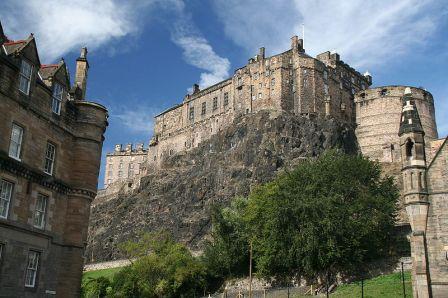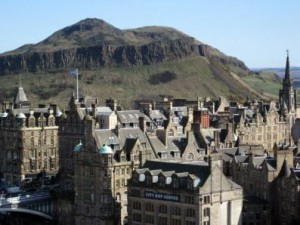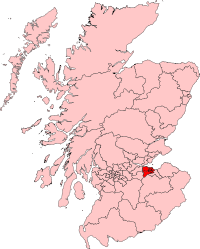
Edinburgh Castle - ©Klaus Hermsen
Edinburgh Castle is the most famous symbol of the city of Edinburgh, with its photo seen on many picture perfect images and postcards of Edinburgh. The castle is located on top of an extinct volcano and offers some spectacular views of the city of Edinburgh and the surrounding areas. The castle attracts large numbers of visitors both from across the UK and around the world keen to visit the historic site. The castle has witnessed a whole range of important and defining moments throughout its history that have had a profound effect on Scottish history. The castle offers visitors history and heritage as well as the best views over the city it is perched above.
Attractions
Edinburgh Castle is located in a stunning location, part of the World Heritage Site, the Scottish capital is among the most beautiful cities in Europe. The Castle is the jewel in Edinburgh's crown and has been part of the Edinburgh landscape since the 12th century, over the years the castle has witnessed a number of important and significant events in Scottish and UK history.
The castle has been under English and Scottish control several times during its long history, it has also been rebuilt and altered a number of times over the centuries. The castle is perched over the top of Edinburgh city and offers visitors great views of the Scottish capital. There are number of attractions for visitors to see and explore further inside the castle and its grounds.
The Scottish Crown Jewels are a popular attraction for visitors and contain the crown, sword and sceptre which are among the oldest regalia in Europe. Visitors can see the glittering crown jewels that have been used a number of times through history in ceremonial duties.
The Great Hall was completed back in 1511 and placed as Scotland's main place of ceremony and state assembly. It was originally commissioned by James IV, but he died in 1513 fighting Henry VII in the Battle of Flodden. The Great Hall has staged the banquet in honour of Charles I, it was held before his coronation as King of Scots in 1633. The majority of the current decoration and design of the Great Hall date back from the 1880s during the period of Queen Victoria. The hammerbeam roof has survived from the 16th century and is one of the very few medieval roofs in Scotland.
The Royal Palace contains rooms that were used by the royal family for many centuries and is here Queen Marie de Guise died in 1560 and Mary Queen of Scots gave birth to James VI in 1566. It was here that the royal family would stay when they were in Edinburgh, whilst the royal family preferred to stay at Holyrood Abbey located a short distance away, they stayed here was it is more secure.
The views of Edinburgh from the castle are a major attraction for visitors, from here you can see for a number of miles around Edinburgh. Visitors can get a sense of why the castle has been regarded as being in a prime strategic position looking over the city. The craggy rock the castle is on provides a great natural defence to potential outside invaders. From the castle you can see Edinburgh New Town and Princes Street and beyond. From some points it is possible to see most of the Lothian region.
St Margaret's Chapel is the oldest building in Edinburgh, it was built back in the 12th century in approx 1130 by David I. The chapel has not always been used for worship, it has been used as a gunpowder store during its long history. Prisons of war exhibition tells visitors the experience from the late 18th century when sailors that were captured from a number of countries were locked up in the underground vaults.
The Scottish National War Memorial is a shrine to those who have sacrificed their lives in conflicts around the world. The National War Memorial was first opened in 1927 as a tribute to those who lost their lives in World War One. There are scenes from World War One inside the building, the memorial has been designed in the Art Deco style by architect Sir Robert Lorimer.
The Mons Meg and the One o’Clock Gun is another attraction located on the site. The Mons Meg is a very large cannon which remains one of the oldest surviving medieval bombards in Europe. The well known One o’Clock Gun has been fired nearly each day since it was first fired in 1861, it is a tradition that has remained from the time when it was used as a time signal for ships in the Firth of Forth and the port of Leith. Visitors can see the One o’Clock Gun fired each day at 1pm (Mon to Sat).
Visitors can enjoy a free guided tour of the castle given by knowledgeable guides with in depth understanding of the castle, the stories, the legends and more. It is a great way for visitors to see the castle and get more information during the tour.
How to Get There
By Car:
The city of Edinburgh is linked to the motorway network in Scotland. The M8 motorway from Glasgow and the A74(M) from England provide access to the city. Edinburgh is approx 2 hours drive from Aberdeen, 2 and half hours from Newcastle, 4 hours from Manchester and 5 and a half hours from Birmingham.
For those using Satellite Navigation systems the postcode to use is EH1 2NG.
The closest parking is found Castle Terrace and Johnston Terrace.
There are a limited number of car parking spaces for disabled visitors at the castle, for those wishing to use them the places should be booked in advance.
By Train:
Edinburgh Waverley Station is the main railway station in Edinburgh, it is located walking distance from the Castle.
There are regular train services from London (King's Cross) to Edinburgh (Waverley station), the journey time is just under 5 hours and the National Express line is currently the fastest intercity railway in the UK.
ScotRail operate an alternative overnight service, the Caledonian Sleeper, takes passengers from London (Euston Station) and Edinburgh 7 nights a week.
Edinburgh Waverley station offer good rail connections to other UK cities such as Aberdeen, Newcastle and York.
Edinburgh has two main train stations namely Edinburgh Waverley located in the city centre and Edinburgh Haymarket station located in the West End.
By Bus/Coach
There is an express bus service from Edinburgh Airport, the Airlink 100 that takes visitors to Edinburgh city centre. The service frequency is every 10 minutes at peak times in the day and every 30 minutes at night.
Mega Bus offers a number of routes to Edinburgh from a number of UK cities and towns.
National Express also offers a number of services to Edinburgh from locations across the UK.
Contact Details
Edinburgh Castle
Castlehill
Edinburgh
EH1 2NG
Scotland
Telephone: +44 (0)131 225 9846
Website: Edinburgh Castle
Facilities & Information
Opening Times:
Opening Dates:
Summer: 09.30 to 18.00 from April to September
Winter: 09.30 to 17.00 from October to March
Further Information:
Admission Prices:
Adults (aged 16 to 59): £11 approx, Child (aged 5 to 15): £5.50 approx, Concessions: £9.00 approx & Children under 5: Free Entry.
There are Cafes on site that provide eating facilities with a range of food including lights snacks, sandwiches, soups, pasta and hot meals and hot and cold drinks.
Map
View Larger Map
For Local Search and Directions see: Edinburgh Castle Map
Tips & Other Considerations
There may be some variations on the opening hours depending on the time of year and the attraction you wish to see. It is wise to double check before going to ensure the attraction you wish to see is open and avoid disappointment.
Always remain alert, vigilant and aware of your surroundings & environment at all times especially your wallet/purse and valuables and ensure they are hidden away from public view (especially at tourist attractions & places with crowds). If you have a bag try to use a shoulder bag with a good quality, strong strap, that is put across your shoulder not on your shoulder making it more difficult for anyone to take your bag.
If you are travelling by car to Edinburgh ensure you are well prepared with maps and Sat Nav to aid your journey, particularly if you are not familiar with the local area and roads. Check traffic news & updates before travelling.
When looking for local car parking in Edinburgh, ensure you fully understand the rules, regulations & charges for car parks and street parking before you park your car. Car parking rules are strictly enforced and any infringement of the rules can result in vehicles being fined, clamped or towed away. The rules & regulations can be complex, if you are not sure it is better not to park there.
If you are travelling by public transport, check for service updates prior to beginning your journey for any delays, disruption or cancellations to services that may impact on your journey. Ensure you have the service timetables for the trains, buses and coaches. Remember when the last services are and ensure you make it to the train/bus/coach stops well in time to avoid missing the service.
Disclaimer: The information given in on this website is given in good faith and to the best of our knowledge. If there are any discrepancies in no way do we intend to mislead. Important travel details and arrangements should be confirmed and verified with the relevant authorities.



